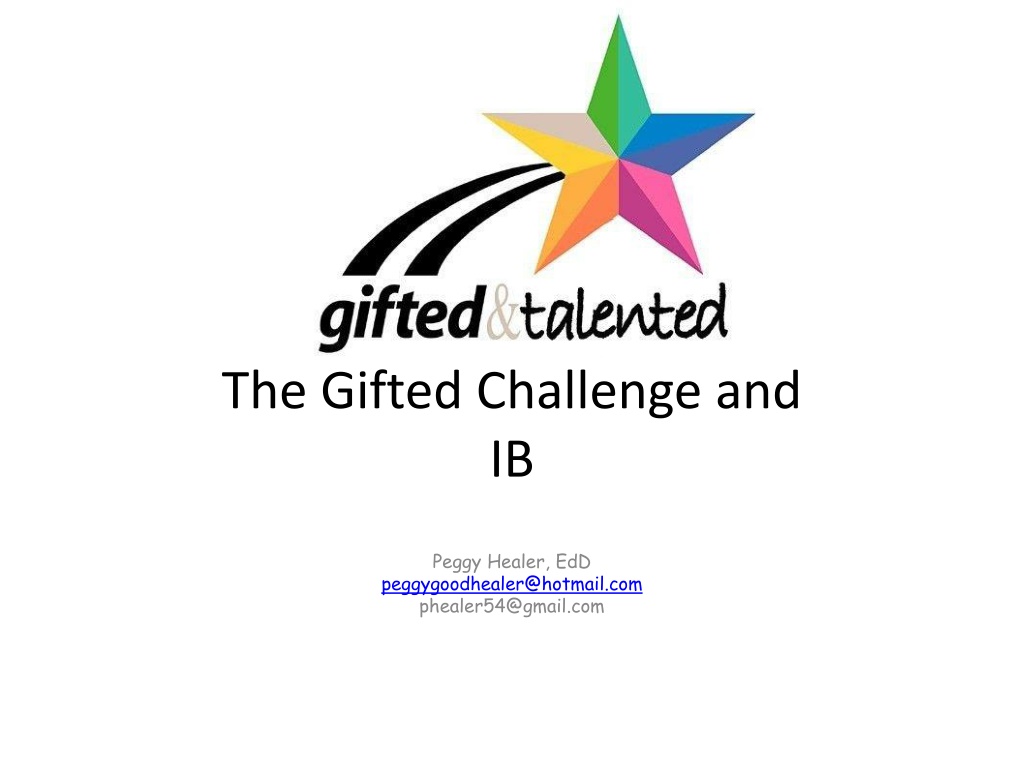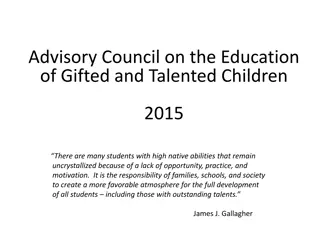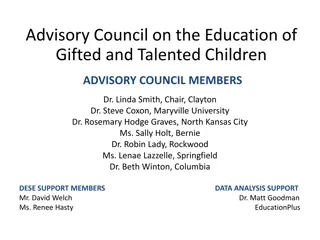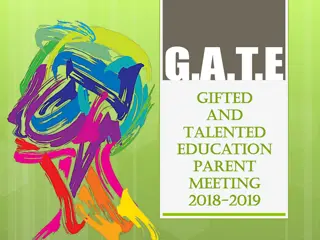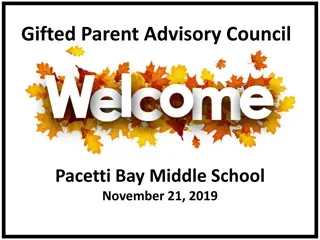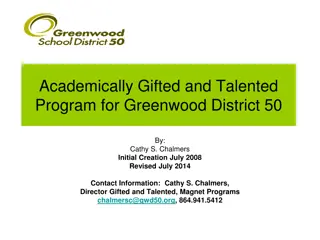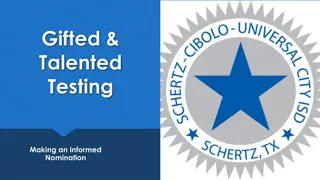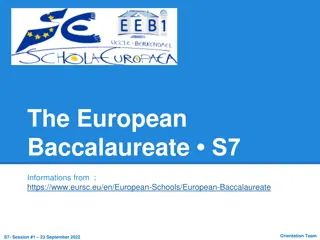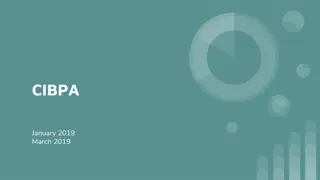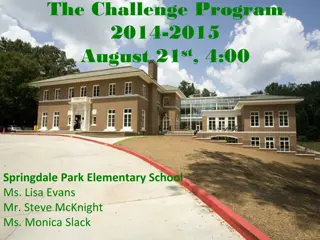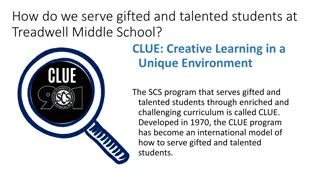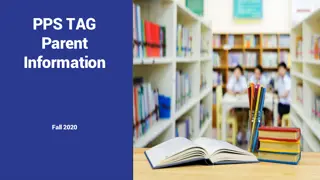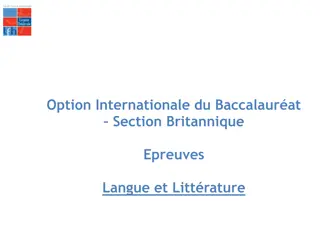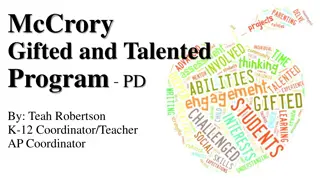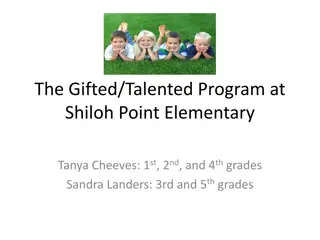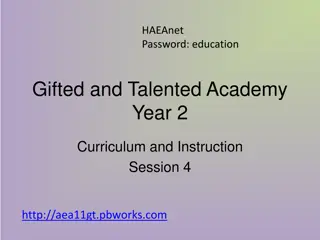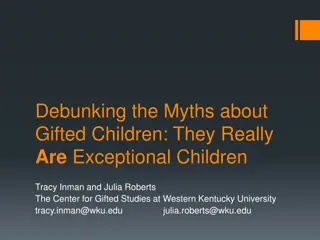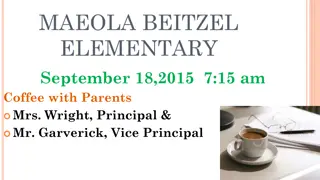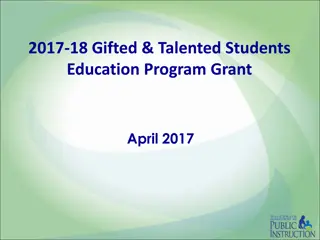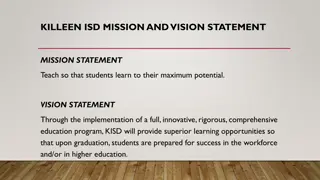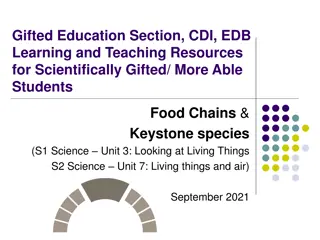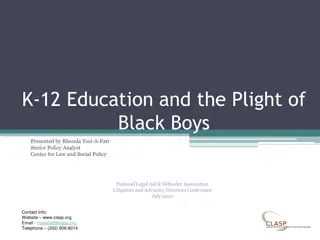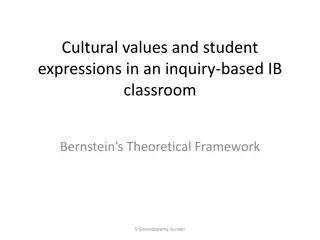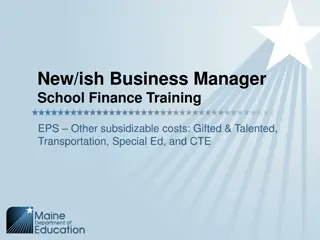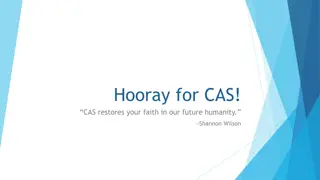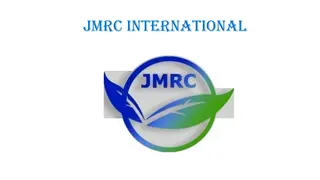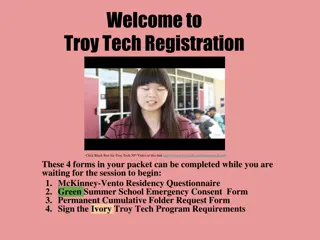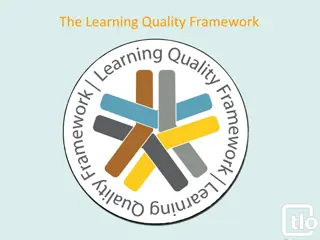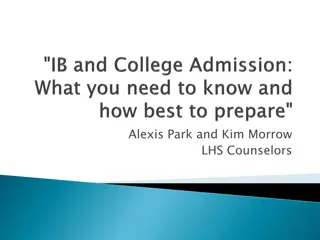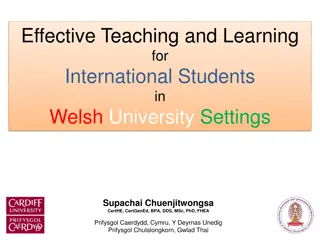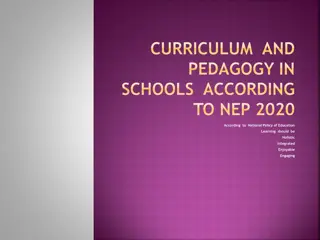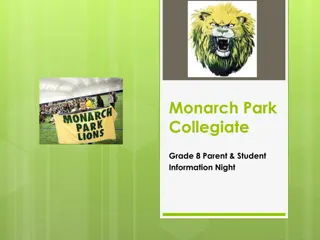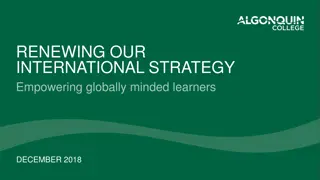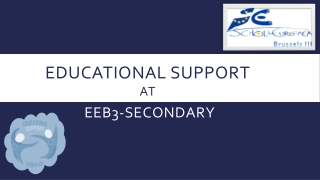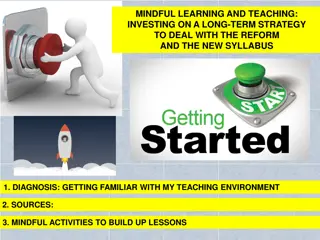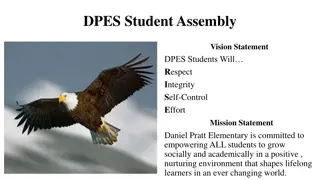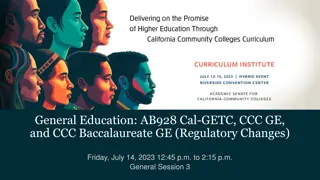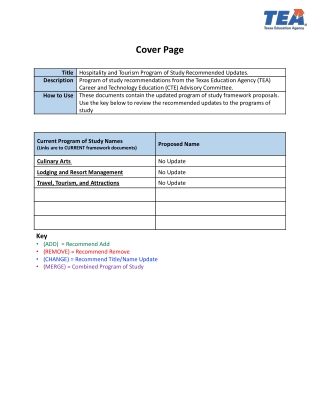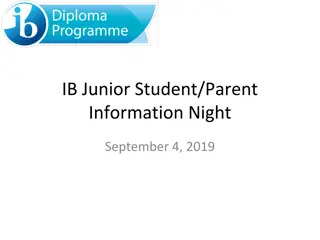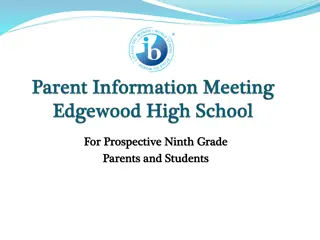Empowering Gifted Students: Insights from International Baccalaureate Framework
Delve into the world of meeting the needs of exceptional students through the lens of the International Baccalaureate Transdisciplinary framework. Explore challenges, benefits, and innovative program ideas to support gifted students within educational standards. Uncover strategies to affirm student identity, enhance self-esteem, and foster an inclusive learning environment that values individual strengths.
Download Presentation

Please find below an Image/Link to download the presentation.
The content on the website is provided AS IS for your information and personal use only. It may not be sold, licensed, or shared on other websites without obtaining consent from the author. Download presentation by click this link. If you encounter any issues during the download, it is possible that the publisher has removed the file from their server.
E N D
Presentation Transcript
The Gifted Challenge and IB Peggy Healer, EdD peggygoodhealer@hotmail.com phealer54@gmail.com
Session Objectives 1. Share and validate challenges and benefits of meeting the needs of exceptional students within the International Baccalaureate Transdisciplinary framework 2. Explore program ideas to address needs of gifted students in alignment with state/provincial requirements and the International Baccalaureate Standards and Practices 3. Explore Inquiry learning experiences to affirm student identify, build student self esteem, value prior knowledge and scaffold and extend learning
Our Gifted- IB Story Background with IB and Gifted History of changes with Gifted Program in alignment with the IB PYP Research on Science through a transdisciplinary Approach Current results after two years of change
Gifted Education and IB Brainstorm with your teammates from your school and/or district your current understanding of IB and meeting the needs of gifted record understanding on chart paper Brainstorm with your teammates from your school and/or district your current understanding of meeting the needs of your gifted students in your district/school- record on chart paper
Meeting the needs of gifted students through the IB PYP Framework Share your Gifted Story Challenges with your table group. Claim: What claims, explanations, or interpretations might you already think you know about IB and meeting the needs of your Gifted Population? Put these on a chart paper Support: What can we see, notice, know, or find that might give support to claims or refute the claims, etc. Question: Is there evidence on the other side? Share your thinking on chart paper with a claim/support/question section on chart paper
Gifted and Talented or exceptionally able What do we mean by gifted? Globally gifted Gifted in specific areas Twice Exceptional
Inclusion Inclusion is an ongoing process that aims to increase access and engagement in learning for all students by identifying and removing barriers (Learning diversity and the IB Programmes: Special educational needs within the International Baccalaureate programmes, 2010- 2013)
Meeting Student Learning Diversity All students in an IB World School will experience positive learning environments based upon the IB s four principles of good practice: Affirming identity Building Self esteem Valuing Prior Knowledge Scaffolding and extending learning
All students are engaged with each other in constructing meaning Learning accomodates the range of abilities and perspectives that will inevitably exist in a heterogeneous classroom. Vgotsky (1978) and Piaget (1928)- highlighted the importance of interaction between the learning that is taking place in the social, affective and cognitive domains. PYP believes that students learning and their attempts to understand their world around them are essentially social acts of communication and collaboration The Primary Years Programme as a model of transdisciplinary learning (pg. 15-16)
Differentiation through grouping to support learning in a transdisciplinary context Dynamic learning environment- students moving from individual work to group work in response to their needs and the needs of inquiries for which they have committed or for that has been designed for them. Students change roles as they move from one group to another- working as a leader or initiator, a collaborating partner, or a contributing member of a larger group General education classroom allows for mixed-ability grouping and such groups change continually depending on student needs The Primary Years Programme as a model of transdisciplinary learning (pg. 16).
Message from Michael Clifton It is the school s responsibility to ensure that its implementation of the PYP is indeed transdisciplinary in nature and adheres to IB programme standards and practices. Questions to consider: Is grouping by ability an effective way and the best way to meet the students learning needs? If yes, how has this been proven? Is the criteria used to group these students based on subjective perceptions and narrow views of intelligence (One or two tests)? Are educators lowering their expectations of students because of their ability group placement? If this is an issue this, why wasn t it an issue last year? Can the non-mandated accelerated math program be implemented in the home classroom with differentiated instruction? Is the school ensuring that all students are involved in a transdisciplinary approach to their learning approach to their learning
The Power of Ummmm By Kath Murdoch https://www.youtube.com/watch? v=LFt15Ig64Ygh
What is an Inquiry Classroom What is an inquiry classroom? mp4
The PYP in Practice The PYP in Practice Video
IB PYP Resources to support Student Needs What is an IB Education? (2012) Language and learning in IB Programmes (2011) Learning diversity and the IB programmes: Special Educational needs within the International Baccalaureate programmes (2010) Programming standards and practices (2010)
Possible ideas for serving Gifted Needs in Compliance with IB Push in intervention model and a 30 minute/day no new instruction intervention period for each grade level: 2-4. During that period, students can be pulled for any intervention (this may include GT, ESL, Special Ed, etc. ) GT intervention specialists plan and co-teach or partner teach with classroom teachers and work with GT and higher achieving students along with identified students. To accomplish this, there is some clustering of students in certain classrooms so that the GT teacher can work with identified in that space. Push in/co-teach and minimal pull out method successfully for many years. The goal is to have all interventions happen MAINLY in the classroom (ESL, Special Ed., GT) Upside is increased rigor for students who are ready for it because the GT teacher works with more than just identified students since she s not pulling her students for 300 mins/week. They still get their required minutes, but most of it is in the regular classroom setting.
Growth Mindset Growth Mindset Feedback Use these language frames when interacting with your students in the following situations. When they struggle despite strong effort: OK, so you didn t do as well as you wanted to. Let s look at this as an opportunity to learn. What did you do to prepare for this? Is there anything you could do to prepare differently next time? You are not there/here yet. When you think you can t do it, remind yourself that you can t do it yet. I expect you to make some mistakes. It is the kinds of mistakes that you make along the way that tell me how to support you. Mistakes are welcome here! You might be struggling, but you are making progress. I can see your growth (in these places). Look at how much progress you made on this. Do you remember how much more challenging this was (yesterday/last week/last year)? Of course it s tough school is here to makes our brains stronger! If it were easy you wouldn t be learning anything! You can do it it s tough, but you can; let s break it down into steps. Let s stop here and return tomorrow with a fresher brain. I admire your persistence and I appreciate your hard work. It will pay off.
Possible Challenges Nature of ability and implications for learning Students may: Reason well (good thinker) Learn rapidly Have extensive vocabulary Have an excellent memory Have a long attention span (if interested) Be sensitive (feelings hurt easily) Show compassion Be perfectionists Be intense Be morally sensitive
Challenges continued Have strong curiosity Ask lots of questions Draw inferences Invent things Love challenges and complexity Have a high degree of perseverance in their interests Have a high degree of energy Prefer older companions or adults
Teaching Strategies Provide a safe, affirming environment to build confidence and self-esteem Cooperative, knowledgeable, accessible schools that welcome parents into the learning partnership are best placed to support the students in overcoming challenges and to optimize learning experiences Teach in line with the IB s approaches to learning and IB s four principles of good practice Support learning in areas in which less satisfactory progress is being made
Teaching strategies should: Ensure learning extension in areas in which the student s exceptional ability is demonstrated Ensure students are challenged to go deeper, with the content taking into account pace, depth and complexity, as opposed to providing more of the same. Create opportunities for students to undertake studies and or programmes at a higher level in areas of exceptional ability (via other organizations and universities). Allow students to undertake studies in different and additional areas of interest
